THE POSTHUMOUS LANDSCAPE III: More Jewish Historical Sites in Western Ukraine
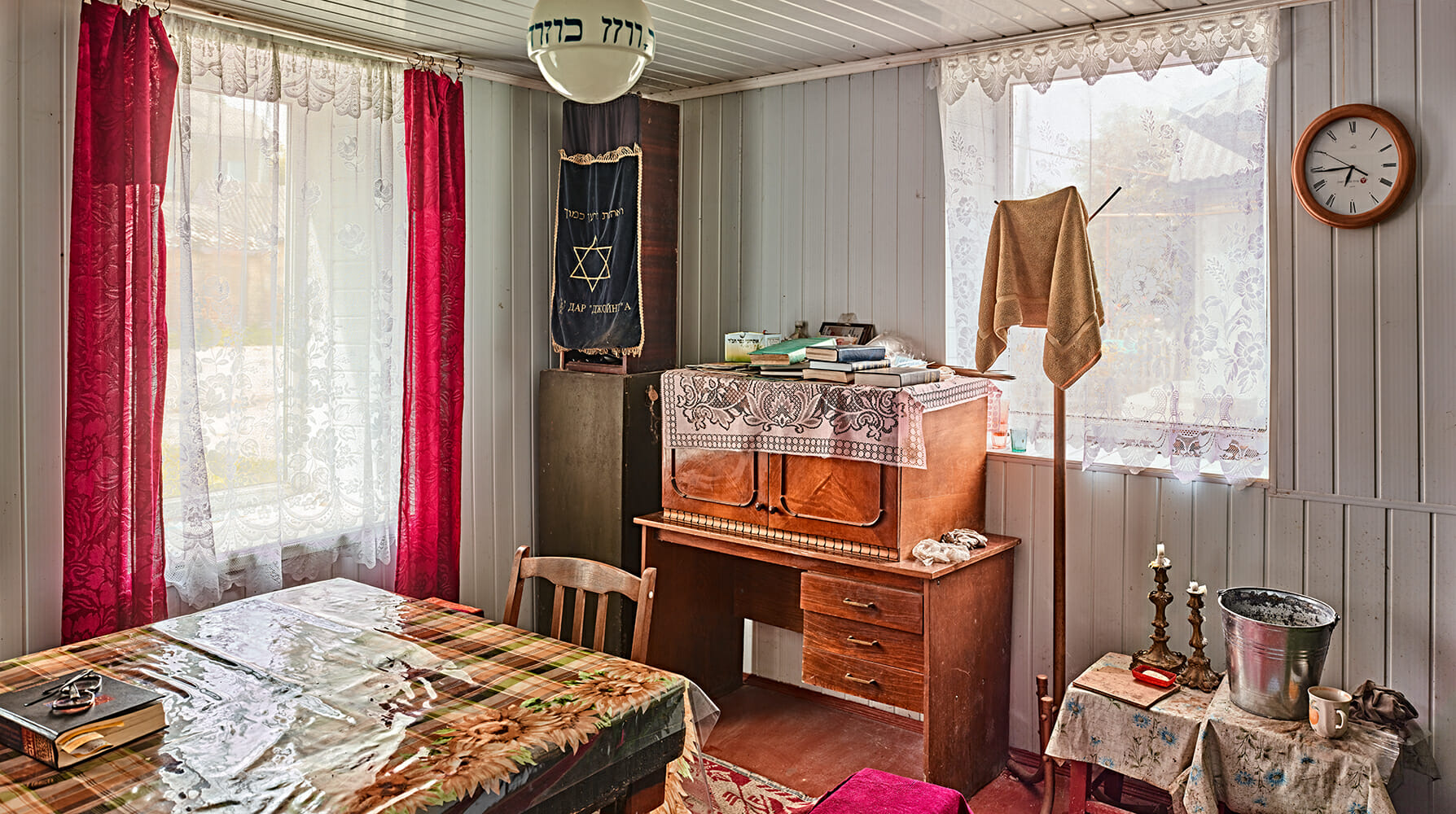
Continuing through February and into March, 2024, Reuben & Helene Dennis Museum, Beth Tzedec Congregation, 1700 Bathurst Street, Toronto (entry at rear from the parking lot). Museum curator: Dorion Liebgott.
Open to the public during synagogue hours, Sunday to Thursday, from 8 a.m. until 7 p.m., Friday until 4 p.m. Open Friday evenings, Saturday, and on Jewish holidays to synagogue attendees.
This is the third in a series of exhibitions at the Beth Tzedec drawn from my work in Poland and Ukraine, depicting the remnants of Jewish life that remained there seventy-five years after the Holocaust. The exhibition features seventeen newly-printed, previously unexhibited images, from a trip to western Ukraine in June, 2016.
Most of the territory of western Ukraine formed part of the historic province of Galicia, which was returned to Poland after the First World War. The remainder of what is today western Ukraine was in the district of Bukovina, which became part of Romania. The largest city of Galicia was Lviv, one of the five major cities of Jewish settlement in historic Poland and which had a Jewish population of well over a hundred thousand before the Second World War. Chernivtsi was the capital of Bukovina and in 1939 had a Jewish population of fifty thousand.
I explored these two cities and surrounding smaller cities and towns during an intense three week trip. The Jewish population of western Ukraine today is less than five thousand, and it is a struggle to preserve the many artifacts of Jewish life from before the Holocaust, including numerous crumbling synagogues and cemeteries in urgent need of restoration. In the major cities of the area, there are numerous examples of architecture owned and/or built by Jews that remain intact and in use. The ongoing conflict in Ukraine underlines the difficulty and urgency of preserving Jewish material culture in areas where the community is small and without resources.
The Evolving Spaces of Kensington Market and Spadina Avenue
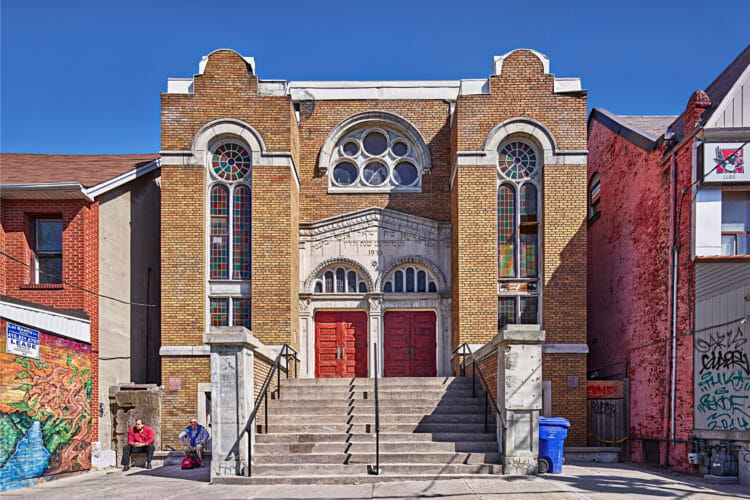
Images installed on loan at MAKOM: Creative Downtown Judaism, 402 College Street, Toronto (just one block east of Bathurst).
PLEASE NOTE: MAKOM is not a public gallery but has a busy schedule of events (see http://makomto.org) and is frequently open for participants and sometimes for passers-by.
For about ten years, I have been making images of the ever-changing built environment along Spadina Avenue and the streets of the Kensington Market area of Toronto. When I first arrived in Toronto in 1971, the area’s historic Jewish character was still largely in evidence. In the 1930s, approximately eighty percent of the city’s 45,000 Jews lived around Spadina Avenue, and were active in the neighbourhood’s thriving businesses, synagogues and communal organizations. Forty years later, there were still many restaurants and textile and fur businesses in the district owned by Jews, as well as a number of functioning synagogues.
As an area populated by and employing many immigrants, Spadina Avenue and Kensington Market are the locus of constant change. The appearance of the major streetscapes today has been shaped largely by the Chinese community, and colourful signs with Chinese characters dominate Spadina Avenue and nearby Dundas Street West. While most Jewish residents have relocated to the northern parts of the city and the suburbs, there are still historical remnants of Jewish life in the Market and nearby, including a few synagogues that cater to downtown Jews, joined recently by MAKOM on College Street.
Special thanks to Evelyn Tauben both for making the shidduch with MAKOM and for curating the mini-exhibition, and also to Rabbi Aaron Levy for his warm welcome.
THE POSTHUMOUS LANDSCAPE: Jewish Historical Sites in Western Ukraine
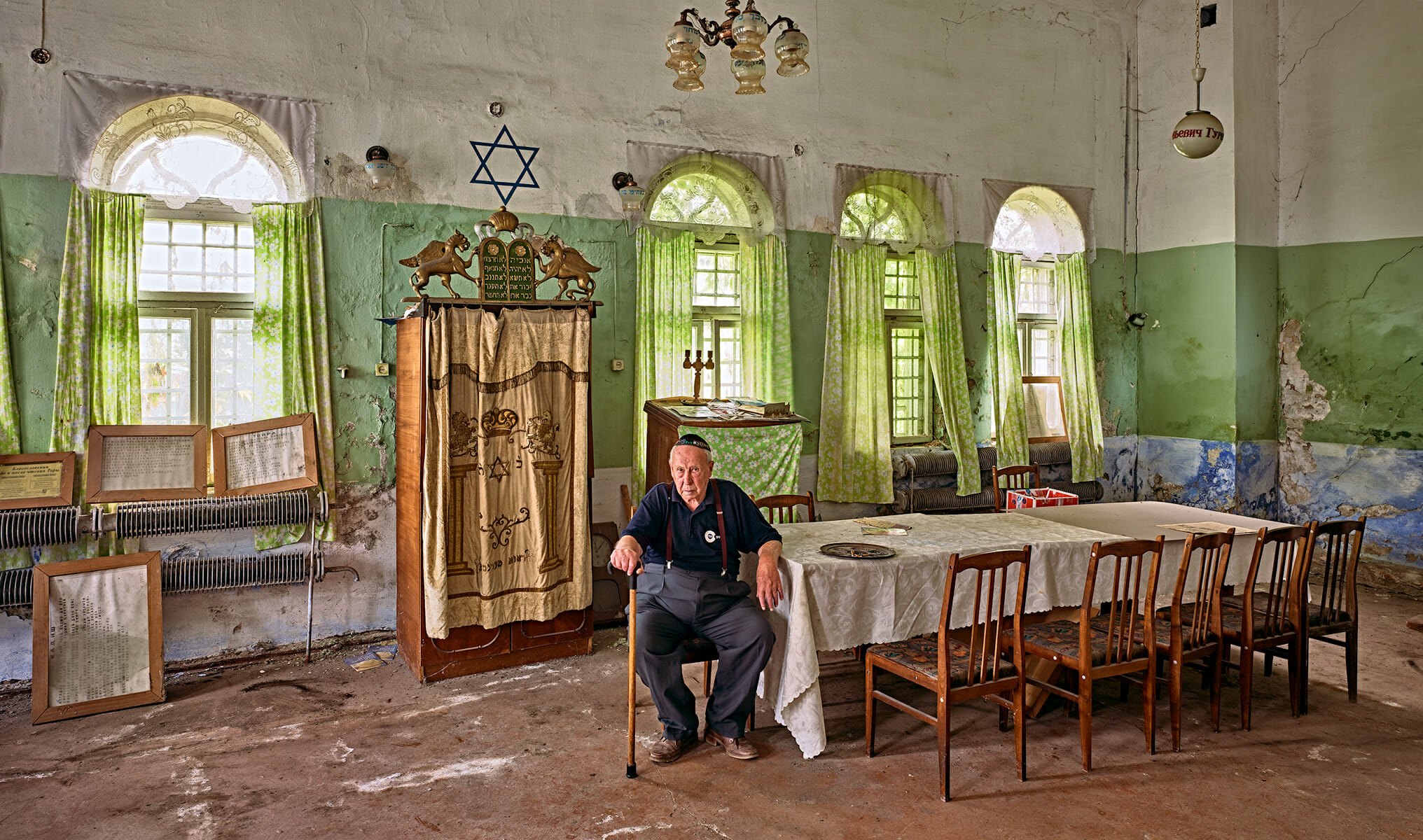
EXHIBITION HAS ENDED. April 24 – May 16, 2022. Adath Israel Congregation, 37 Southbourne Avenue, North York, Ontario.
Due to the ongoing conflict in Ukraine, these images of Jewish historical sites in the western part of the country have taken on added poignancy. Rabbi Adam Cutler, the recently appointed spiritual leader of the Adath Israel Congregation in Toronto, had been employed at the Beth Tzedec Congregation when these image were first shown there in 2017. It was under his initiative that this exhibition was remounted for almost a month at his new congregation around the Passover holiday in 2022.
In June 2016, for three weeks I explored the cities of Lviv and Chernivtsi and their surroundings, drawn to the area by its abundant Jewish material culture. Lviv, part of Poland before the war, and Chernivtsi, part of Romania, once had significant and large Jewish populations, as did the nearby towns. Today, western Ukraine’s much-reduced Jewish population of a few thousand faces an overwhelming task as it struggles to preserve community sites and historical artifacts, even with significant help from abroad.
Jewish heritage sites have enjoyed legal protection in Ukraine since the mid-nineties, but because of the history of destruction during both World War Two and the Soviet era, followed by two decades of neglect, many sites are in precarious condition. Though Jewish sites in western Ukraine do not appear to be in any danger because of the war with Russia, it is difficult to know how much damage has been incurred by sites in the rest of the country and what will become of those sites in the hoped-for aftermath of the conflict.
THE POSTHUMOUS LANDSCAPE: Jewish Historical Sites in Poland and Western Ukraine
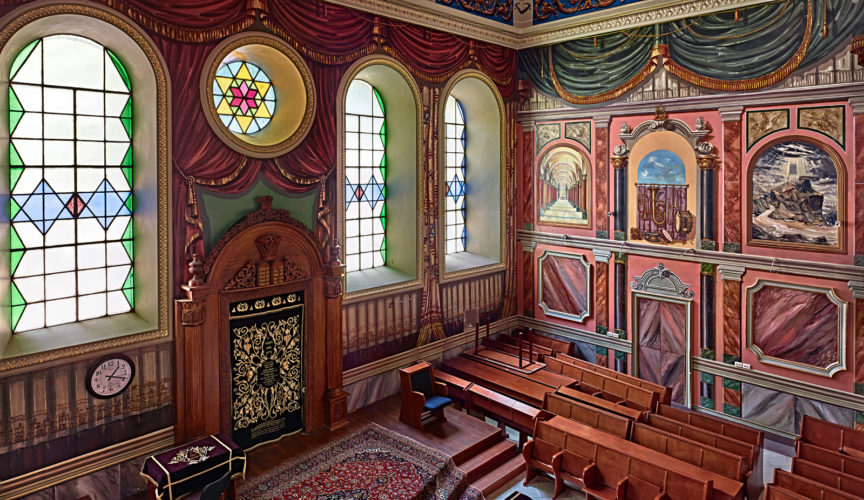
EXHIBITION HAS ENDED. November 2019 until closure due to Covid. DARCHEI NOAM CONGREGATION, 864 Sheppard Avenue West, Toronto. Open for viewing during the week from 9:30 a.m. to 5 p.m., and during synagogue services on Saturday morning and holidays. (Please call synagogue office at 416-638-4783 to confirm.)
The landscapes of Poland and western Ukraine offer substantial rewards to the Jewish traveller seeking a connection with what existed before the great catastrophe of the Hitler years. Since the late 1970s and especially since the fall of Communism, Jews of the post-war generations in North America and Israel have been “returning” to Eastern Europe in ever-increasing numbers. For most the quest is to set foot in the ancestral home, to visit family burial sites if they exist, and to uncover family records in provincial archives.
My interest in what remains of Jewish life in Eastern Europe as a photographic subject was sparked by several trips to Poland to make documentary films concerning the Holocaust. On all those occasions I was unexpectedly surprised and deeply moved by both the quality and quantity of Jewish material culture—remnants of Jewish life—that I saw wherever I went. Although the great Jewish communities of Eastern Europe were destroyed by the Nazis, and the survivors persecuted and cast out in the Soviet era, evidence of centuries of Jewish life remains in abundance almost everywhere.
(This exhibition at Darchei Noam Congregation in Toronto was previously at the Yiddish Book Center in Amherst, Massachusetts. It brings together a selection of my photos from previous exhibitions on Jewish historical sites in Poland and western Ukraine.)
GARDENS OF MEMORY – An Installation
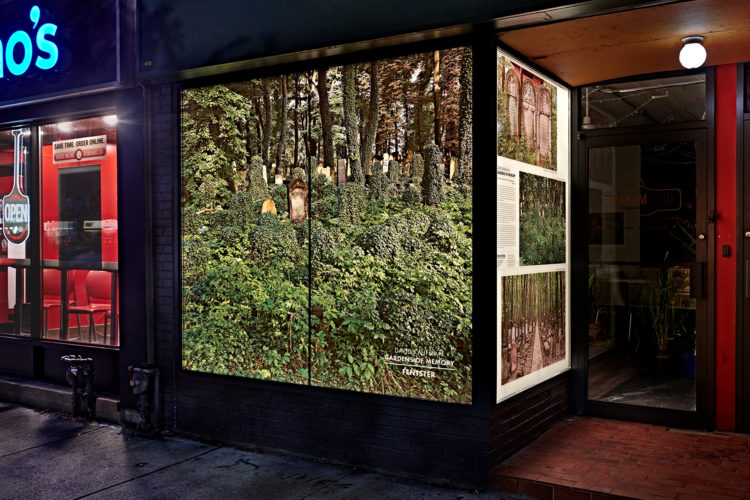
EXHIBITION HAS ENDED. At the FENTSTER window gallery, 402 College Street (east of Bathurst), Toronto, Ontario, Canada, July to October, 2019.
The FENTSTER window gallery, curated by Evelyn Tauben, is described as “a window onto Jewish life through art.” Evelyn has put together twelve exhibitions in the approximately four years since she started the project in the front window of the Makom downtown Jewish community centre. The featured artists cover a wide and eclectic range of both media and Jewish interests.
This installation in the front-facing window is comprised of a section of a photograph I made at the back of the Miodowa Street Jewish cemetery in Krakow, Poland, in 2011. The photograph encapsulates both the unusual aesthetic appeal of historic Jewish cemeteries in Poland and other East European countries and the challenges they present both in maintenance of the sites and the preservation of Jewish monuments. The side window contains the full image from Krakow, as well as images of two other Jewish cemeteries, in Warsaw and the town of Ozarow.
I have called these cemeteries both “gardens of memory” and “gardens of history” because each one encapsulates the rich history of their respective communities, tragically destroyed in the Holocaust. The cemeteries themselves were targeted for destruction during both the Nazi and Soviet eras, and only a small percentage have survived with most of their monuments intact.
THE POSTHUMOUS LANDSCAPE: Jewish Historical Sites in Poland and Western Ukraine
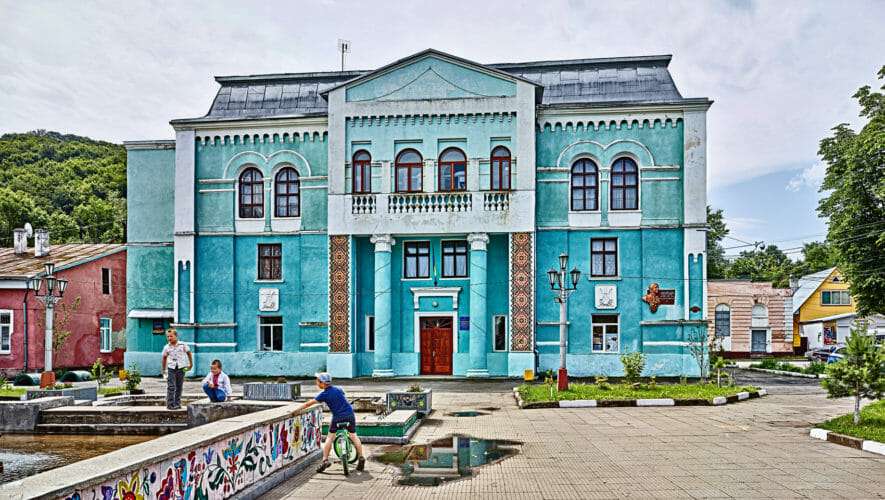
EXHIBITION HAS ENDED. April 28 to September 30, 2019, Yiddish Book Center, 1021 West St., Amherst, MA 01002, U.S.A. The Center is open Sunday to Friday from 10 a.m. to 4 p.m. For more information see the Center’s website: https://www.yiddishbookcenter.org/visit/hours-directions-accommodations
The landscapes of Poland and western Ukraine offer substantial rewards to the Jewish traveller seeking a connection with what existed before the great catastrophe of the Hitler years. Since the late 1970s and especially since the fall of Communism, Jews of the post-war generations in North America and Israel have been “returning” to Eastern Europe in ever-increasing numbers. For most the quest is to set foot in the ancestral home, to visit family burial sites if they exist, and to uncover family records in provincial archives.
My interest in what remains of Jewish life in Eastern Europe as a photographic subject was sparked by several trips to Poland to make documentary films concerning the Holocaust. On all those occasions I was unexpectedly surprised and deeply moved by both the quality and quantity of Jewish material culture—remnants of Jewish life—that I saw wherever I went. Although the great Jewish communities of Eastern Europe were destroyed by the Nazis, and the survivors persecuted and cast out in the Soviet era, evidence of centuries of Jewish life remains in abundance almost everywhere.
(This exhibition at the Yiddish Book Center in Amherst, Massachusetts, brings together a selection of my photos from previous exhibitions on Jewish historical sites in Poland and western Ukraine.)
THE POSTHUMOUS LANDSCAPE: Jewish Historical Sites in Western Ukraine
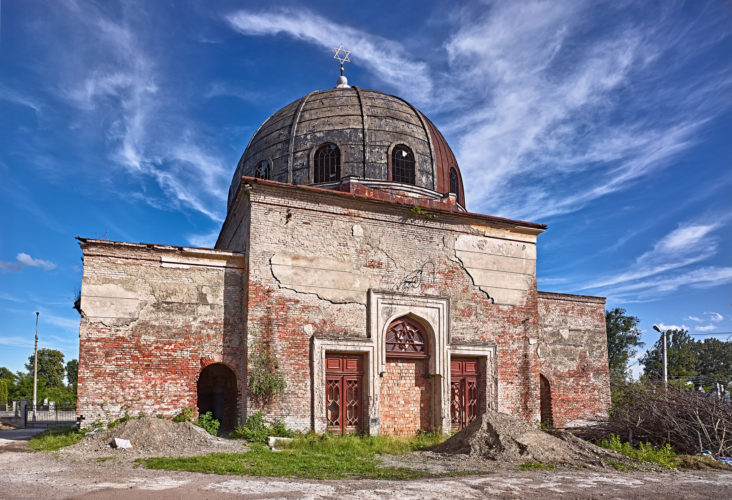
EXHIBITION HAS ENDED. May 2 to August 27, 2017, at the Reuben & Helene Dennis Museum, Beth Tzedec Congregation, 1700 Bathurst Street, Toronto. Open to the public during synagogue hours, Sunday to Thursday, from 8 a.m. to 7 p.m., Friday until 3 p.m. Open Friday evening and Saturday to synagogue attendees.
More than seventy years after the Holocaust, western Ukraine is still replete with remnants of Jewish communal life, but the history of that community has all but vanished from popular consciousness. In June 2016, for three weeks I explored the cities of Lviv and Chernivtsi and their surroundings, drawn to the area by its abundant Jewish material culture. Lviv, part of Poland before the war, and Chernivtsi, part of Romania, had significant and large Jewish populations, as did the nearby towns. Today, western Ukraine’s much-reduced Jewish population of a few thousand faces an overwhelming task as it struggles to preserve community sites and historical artifacts, even with significant help from abroad.
Like my earlier exhibition in 2013 that explored the Polish landscape, this collection of photographs depicts the physical remnants of Jewish life in western Ukraine: synagogues, cemeteries, memorials, public spaces and architecture, some functioning, some repurposed and some in ruins. Jewish heritage sites have enjoyed legal protection in Ukraine since the mid-nineties, but because of the history of destruction during both World War Two and the Soviet era, followed by two decades of neglect, many sites are in precarious condition. However, in recent years, local civic and cultural authorities have shown a new interest in Jewish heritage and are taking significant steps to promote awareness of the value of Jewish material culture and to encourage its preservation.
Part of the Scotiabank Contact Photography Festival.
ARCHITECTURAL DEVOLUTION: Industrial Buildings in a Post-Industrial Age
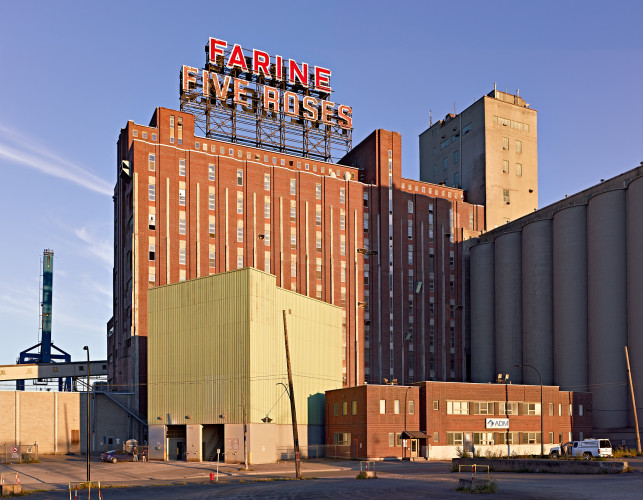
EXHIBITION HAS ENDED. May 3-28, 2016, TWIST GALLERY, 1100 Queen Street West, Toronto. Gallery hours: Tuesday to Saturday, 11 a.m. to 6 p.m.
Opening Reception: Wednesday, May 4, 6 to 9 p.m.
Although the industrial building will exist as long as we make things, the imposing presence of late 19th century and early 20th century brick, concrete and steel factories that once shaped our great cities is gradually coming to an end. In this new exhibition, I have selected photographs from both recent and never-exhibited earlier work, to survey the fate of older industrial buildings, especially within the de-industrialized urban context. I have drawn on both digital and film-original large format images to create highly-detailed photographs which illustrate the conditions of buildings purpose-built for various enterprises, many of which have outlived their original functions.
The exhibition includes images of concrete grain elevators in Trois Rivieres and Buffalo, brick factories in Berlin and Toronto, and gleaming storage tanks in Montreal. The fate of older industrial building is as varied as the structures themselves. Some sites I photographed no longer exist. While some multi-story factories can be transformed into commercial and residential spaces, many structures cannot be adapted and are allowed to deteriorate or are demolished. My depiction of these buildings is part of my ongoing work in documenting architectural history in Toronto, where I reside, and Montreal, the city of my birth.
Part of the Scotiabank Contact Photography Festival.
EARLY SUNDAY MORNING
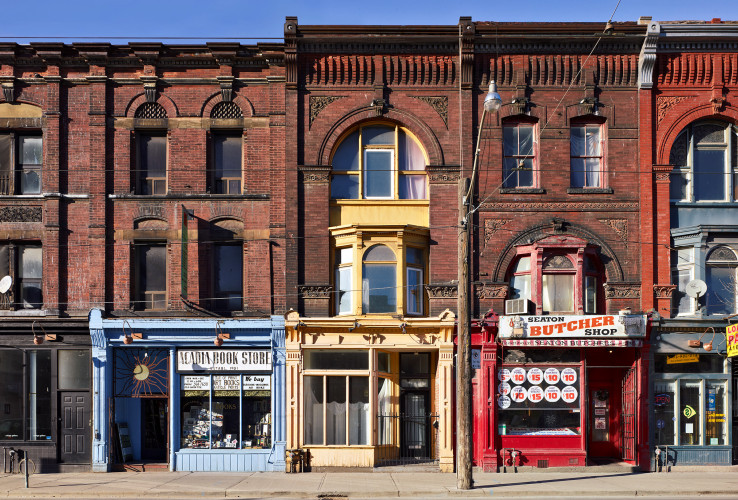
EXHIBITION HAS ENDED. On display from June to mid-October, 2013, at Image Foundry, 1581 Dupont St., Toronto. Original exhibition took place May 1-26, 2013, at Twist Gallery, 1100 Queen St. West, Toronto.
I am pleased to announce that I am particpating once again in Toronto’s annual Contact Photography Festival. Early Sunday Morning features new architectural photographs I have made over the past three years which illuminate the rich visual texture of the city’s disappearing heritage streetscapes. The heart of the exhibition is a series of images of buildings on Queen Street. These three-story brick structures, many dating back to the 1880s, are depicted in highly-detailed, large-scale prints which highlight their beautiful, intricate masonry and richly coloured facades as revealed by morning sunlight. The idea for the show was inspired by Edward Hopper’s 1930 painting of the same name and his aesthetic treatment of similar subject matter in early twentieth century New York. Many of these late nineteenth and early twentieth century buildings in Toronto are threatened today by the unprecedented pace of redevelopment downtown. Early Sunday Morning is both a photographic “cri de coeur” for these unheralded early buildings and a celebration of a century-old era in the city’s architecture.
Early Sunday Morning Press Release
BREAKING POST-CONTACT NEWS: Owing to the generosity of Dimitri Levanoff, master printer and proprietor of Image Foundry, sixteen of the twenty-four images in the original exhibition will be on display all summer at Image Foundry’s excellent and capacious exhibition space behind the front office. If you want to see these photographs again or if you or someone you know missed the original show, this is a great opportunity to see what Toronto Life, NOW Magazine, and Xtra!, as well as several on-line sites, named as one of the must-see, can’t-miss exhibitions of the 2013 edition of the Contact Photography Festival.
If you would like to meet me to talk about the photographs, please contact me for an appointment through this site’s contact page.
BUILT TO LAST: Montreal’s Enduring Architecture
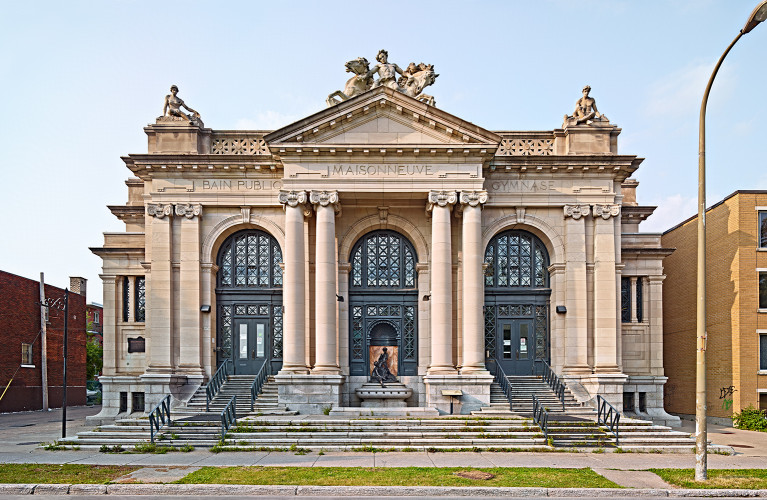
EXHIBITION HAS ENDED. April 28 to May 29, 2015, Mon-Fri 1-6 pm, Sat-Sun 11 am-6 pm, IX Gallery, 11 Davies Ave., Suite 101, Toronto.
Montreal was Canada’s most important city for well over a century, and its architectural heritage, which dates back to the era of New France, remains unparalleled in Canada. I was born and educated in Montreal, and beginning in 1984, I travelled from my home in Toronto back to my native city almost every year to make images of its built environment. Over three decades I have captured a wide range of the city’s buildings: its distinctive residences, its heritage landmarks, many commercial and industrial structures, and numerous religious facades. I am presenting about two dozen of those images in this exhibition, part of the Scotiabank Contact Photography Festival for 2015.
VESSELS OF SONG: Faces of New Jewish Music (Take II)
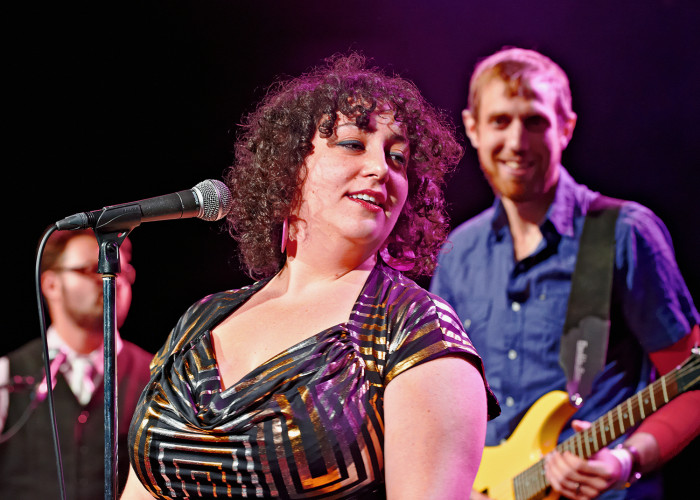
EXHIBTION HAS ENDED. Expanded version of the exhibition, from Dec. 8, 2014, to Feb 27, 2015, at the Reuben and Helene Dennis Museum, Beth Tzedec Congregation, 1700 Bathurst, Toronto. Exhibition first mounted in August 2014 at the Miles Nadal JCC.
The revival of popular Yiddish music has to rank as the most distinctive development in Jewish culture of the late 20th century. As I have written elsewhere on this site (see Yiddish Music in Pictures on the Writings page), I only became aware in 1998 of the breadth of this revived interest in Yiddish music, some twenty years after it began. What distinguished this revival was the determination of young musicians not to merely imitate what was played by earlier generations of klezmorim (from the Hebrew klei zemer, meaning “vessels of song”) but to create new music inspired by the distinctive modes and rhythms of 19th century Jewish Bessarabia as well as their transplanted early 20th century, jazzier, American counterparts. The revival gave birth to Jewish music festivals all around the globe, including KlezKanada in Montreal and Ashkenaz here in Toronto. Since 1998, I have filmed and photographed a wide cross section of the new klezmorim at these events, both the seminal figures in the revival as well as scores of young people who are the genre’s latest practitioners and its biggest fans.
THE POSTHUMOUS LANDSCAPE: Jewish Sites of Memory in Poland Today
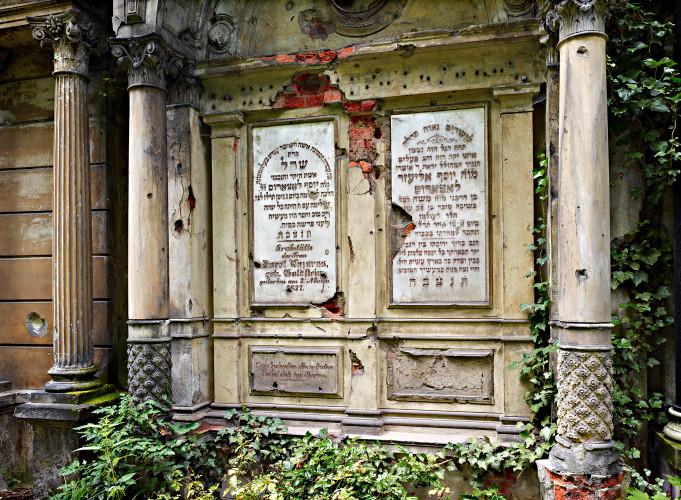
EXHIBITION HAS ENDED. Reuben & Helene Dennis Museum, Beth Tzedec Congregation, 1700 Bathurst Street, Toronto. October 2013 to March 2014.
Guest Curator: Evelyn Tauben
I made my first trip to Poland in 1992 for CBC’s The Fifth Estate. My next trips were also for documentary film work, in 2002 and 2007. On all these occasions I was struck by the richness and beauty of Jewish material culture in the land most often associated by Jews with the Holocaust. I returned a second time in 2007, in September, to begin making still photographs in the Jewish Cemetery in Lodz, the largest in Europe, and I have returned to Poland seven more times since.
Poland, for a thousand years, was the home of a diverse Jewish community that became the most populous and most important in Europe, and the world. I have travelled there to photograph the heritage remains of that society which include many historic cemeteries, ruined and restored synagogues, former Jewish neighbourhoods and ghettos, buildings and other cultural artifacts, as well as physical remnants of the community’s demise in the Holocaust.
Partly due to the efforts of Evelyn Tauben, guest curator for this exhibition and my colleague, the 2013 edition of Holocaust Education Week agreed to sponsor an exhibition of this work, and Dorion Liebgott, curator of the Reuben & Helene Dennis Museum at the Beth Tzedec Congregation, agreed to provide the venue for the show. The exhibition features twenty-six large scale colour prints that survey a variety of Jewish sites, some terrible but many surprisingly beautiful, all part of a civilization whose remnants are slowly being reclaimed by contemporary Poles and Jews the world over.
THE RITE OF RETURN: Canadian-Jewish Artists and Contemporary Poland
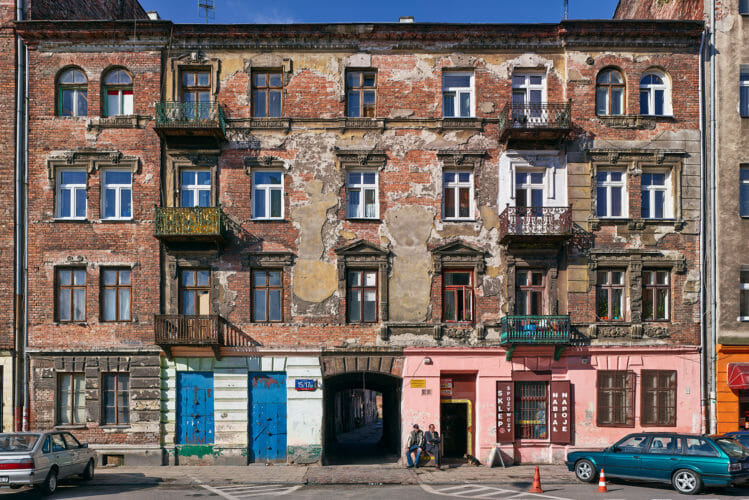
Wednesday, March 12, 2014, 7 – 9 p.m., Beth Tzedec Congregation, 1700 Bathurst Street, Toronto
This program will open with a guided tour of my photo exhibition, The Posthumous Landscape: Jewish Sites of Memory in Poland Today, led by me and my colleague, curator Evelyn Tauben. The evening will continue with a roundtable discussion in which Evelyn and I will be joined by theatre artist Michael Rubenfeld and filmmaker Francine Zukerman. The four of us will discuss our experiences working in Poland, the resurgence of Jewish culture there, and an increasing Canadian-Jewish connection. A reception will follow.
The program is sponsored by the Polish Jewish Heritage Foundation of Canada.
Admission: $8 for PJHF members, $10 for non-members.
Toronto’s Heritage Streetscapes: Can They Be Saved?
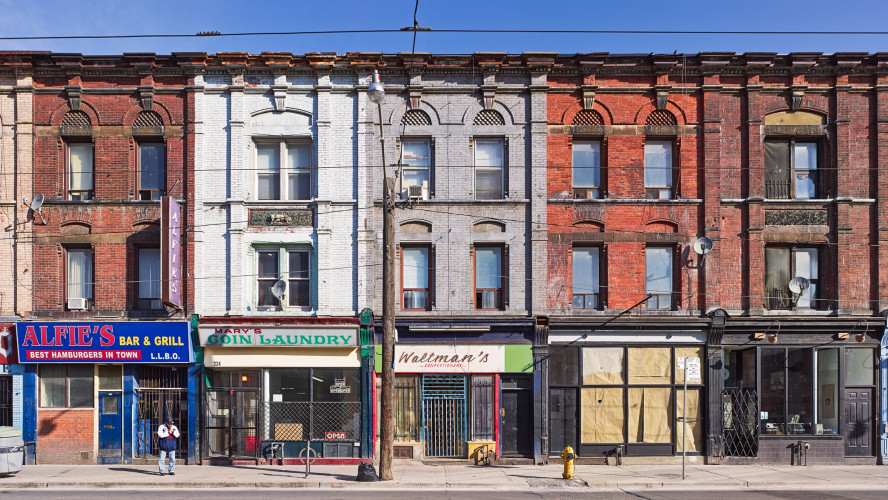
A Conversation with Margaret Zeidler, Deanne Taylor and Adam Vaughan | Saturday, May 11, 2013, at 2:30 p.m. at the Twist Gallery, 1100 Queen Street West, Toronto
Three prominent figures concerned with Toronto’s development and the preservation of neighbourhoods discuss the uncertain future of Toronto’s heritage streetscapes. The past decade has seen the most rapid redevelopment of downtown Toronto in more than half a century which has altered beyond recognition the appearance and character of many parts of the city. The panelists, all of whom have engaged actively in development and planning politics, will discuss what can be done to preserve Toronto’s oldest existing streets and buildings in the face of rampant condo construction and the explosive demand for inner city housing. The panel discussion is being held in conjunction with my exhibition, Early Sunday Morning (see above).
Margaret Zeidler is an architect and founder and president of Urbanspace Property Group specializing in the adaptive reuse of old buildings. Projects include 401 Richmond and the Robertson Building (home to the Centre for Social Innovation, created by Urbanspace in 2004). She is the recipient of the “Jane Jacobs Prize”, the Toronto Untitled “Best Friend of the Arts” Award, and the Order of Ontario.
Deanne Taylor is a playwright and co-founder of the award-winning theatre company, VideoCabaret. Deanne’s interest in city planning goes back to the eighties when she created The Hummer Sisters who ran for Mayor of Toronto, and with the help of hundreds of artists and musicians came second with 10% of the vote. Since then Deanne has written and directed many election-cabarets and plays and has produced twenty plays by Michael Hollingsworth dramatizng the entire history of Canada.
Adam Vaughan is a Toronto city councillor representing Ward 20, Trinity-Spadina. For about 30 years, Vaughan worked as a political journalist for City-TV / CP24 and for CBLT in Toronto. He has been heavily involved in the use and reform of the planning process to protect the quality of neighbourhoods within his ward. He is also a strong advocate for the arts and sits on Toronto’s Planning and Growth Management Committee, the Toronto Arts Council, and other boards.
A Psychogeographic Stroll Around Queen & Ossington with Shawn Micallef
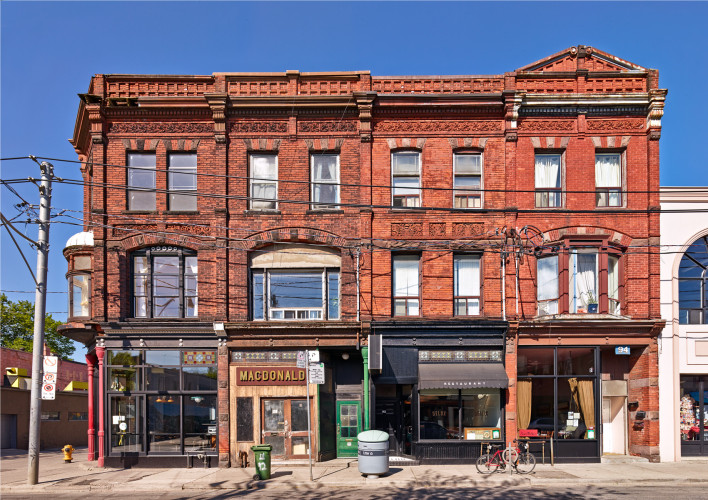
Thursday, May 9, 2013 | 7 – 9 pm | FREE | Meet at Twist Gallery, 1100 Queen Street West, Toronto
Explore often unnoticed spots and side-streets of the Queen and Ossington area with Shawn Micallef ,“Toronto’s most famous flaneur” (blogTO), the author of Stroll: Psychogeographic Walking Tours of Toronto (2010), an editor of Spacing Magazine and a Toronto Star columnist on how we live in the GTA. The tour begins with an artist talk by me about my new photographs of Toronto on display at Twist Gallery. Then Shawn will lead a signature stroll past some of the heritage buildings featured in the exhibition, talking about the city as the group passes through it, and ending up in a neighbourhood watering-hole.
The walking tour is FREE but advanced registration is kindly requested, please email info@evelyntauben.com
Song of the Lodz Ghetto: Premiere in Poland
7 p.m., September 5, 2012, Museum of Cinematography, Lodz, Poland
My documentary film, Song of the Lodz Ghetto, finally had its long-awaited (awaited by me) premiere in Poland in early September. The screening was sponsored by the Dialogue Centre of Lodz whose mandate is to foster intercultural connections between the city’s four historic ethnic groups: Poles, Jews, Germans and Russians. The screening, with Polish sub-titles, was highly successful and attracted about 135 viewers to a modern state-of-the-art cinema that seats only about 100. People were sitting in the aisles and not a sound was heard in the audience (except appropriate reactions) for the film’s entire two hour running time. Most moving for me was that the audience included members of the family of Yankele Herszkowicz, the famous street singer of the Lodz Ghetto, whose life story forms a major part of the documentary. Because of the audience demand, I anticipate there will be another screening in Lodz sometime soon.
KlezKanada Yiddish Summer Festival
August 20-26, 2012, Camp B’nai Brith, Lantier, Quebec
In addition to showing photographs, I had screenings of two films, my first film, A. M. Klein: The Poet As Landscape, and my latest, Song of the Lodz Ghetto. I also spoke on several panels, one with Sara Tauben who discussed her research for her book on Montreal synagogues, Traces of the Past, which contains a portfolio of my photographs. I particpated on two other panels, one dealing with cultural work and impressions of Jewish life today in Poland, and a roundtable discussion about Jewish filmmaking, with Gary Beitel and Eric Anjou.
